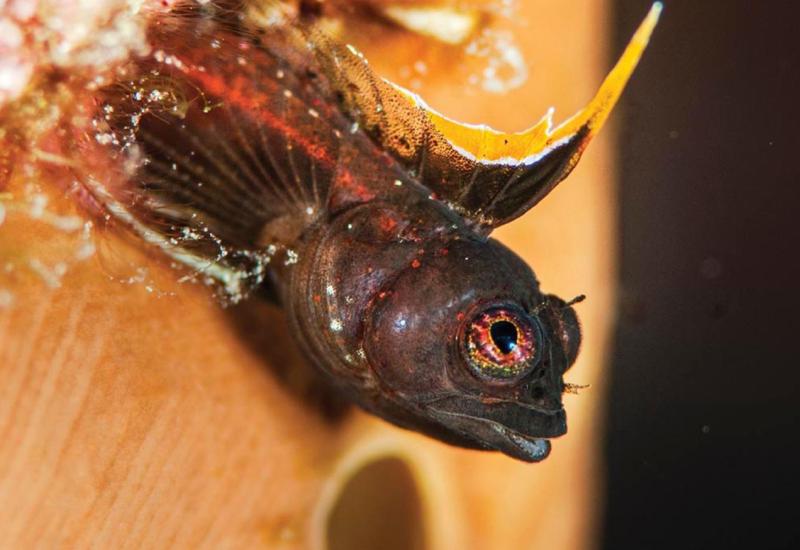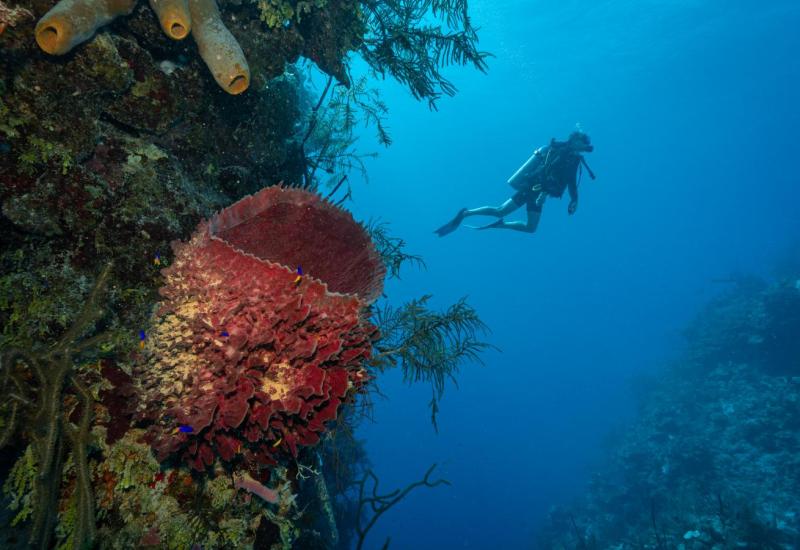Divers Guide to the Dominican Republic

Scott JohnsonWe challenge you to come away unmoved by the humpback whale experience on the Silver Bank. Charters depart from Puerto Plata.
Good to Know
Language: Spanish. If you stick to the tourist areas, you’ll find most employees speak English. However, if you explore local cities, consider hiring an English-speaking guide.
Signature Dish: Habichuelas con dulce, aka sweet cream of beans. It’s a puddinglike dessert made from butter, red or other variety of beans, typically served during Lent.
Signature Topside Activity: Try waterfall hiking. Many operators guide you on a tour of 27 waterfalls, where you get to jump, slide and swim your way down these nature-carved playgrounds.
Main Airport: Punta Cana airport, PUJ, is the country’s busiest, and the one with the greatest availability of flight options.
Water Temp/Visibility: Water temperatures vary from 76 degrees in winter to 83 degrees in summer. Visibility is typically 60 feet or greater.
Travel Tip: If you leave the resort bubble, you will save money on any meals or tours if you pay with DR pesos. Get the best exchange rates from ATMs on island.
This renowned beach destination remains one of the most visited islands by Americans thanks to its stellar lineup of all-inclusives. But the Dominican Republic is so much more than swim-up bars and white-sand beaches. It delivers both easy reef dives perfectly suited to newer divers and caves that challenge even the most experienced divers. Plus, every winter, the offshore Silver Bank draws in humpback whales looking to mate and give birth — which gives snorkelers some of the most intimate big-animal encounters on the planet. With so much on the menu, get ready to drop in and choose the side of the DR that best suits your style of adventure.
Big Animals
Calf Nursery
The humpback whale experience on the Silver Bank is an undeniably magical experience. This shallow bank, midway between the Dominican Republic and the Turks and Caicos Islands, provides ideal conditions for North Atlantic humpback whales to mate, give birth and train their young. As a result, they come by the thousands January through April, spending weeks at a time. The experience is snorkel-only — Silver Bank is part of the Sanctuary for the Marine Mammals of the Dominican Republic — but this allows guests to swim closer without spooking the whales. Moreover, most liveaboards visit the area for a week at a time, allowing visitors to observe a variety of behavior and learn the meaning behind the actions.
Reefs
Day-Tripper
The island of the Dominican Republic is lovely, but so too are its satellite islands. Saona and Catalina, found off the southern coast, are both protected as national parks. Choose Saona for its reefs, considered some of the healthiest in the country, and the frequent sightings of nurse sharks and spotted morays. Uninhabited Catalina Island offers wall dives and reefs, home to lobsters, yellow stingrays and moray eels. A bonus of visiting either is beach time: Both destinations offer idyllic stretches of white sand, as well as offshore shallow sandbars perfect for lounging.
Fishing Village
The hideaway that is the town of Bayahibe owes its roots to the local fishermen who first recognized it as a choice access point to thriving reefs. Today, it’s better known as the beachside hideaway popular among divers looking to lay eyes on the offshore sites. The diving is easy, with clear water free of currents. Plus, with most sites found no farther than 15 minutes by boat, you’ll spend more time in the water.
Caves
Don’t Be Afraid of the Dark
To any cave lover, it’s no surprise that the pastime here has a huge following, spearheaded by the nonprofit organization Dominican Republic Speleological Society, or DRSS. Its mission is the “exploration, survey and conservation of submerged caves in the DR.” Not only do its members film their journeys, allowing even armchair explorers the chance to see inside these wonders, but they’re also happy to share their resources with trained cave divers looking for local know-how. Online, they share ample information about 26 of the DR’s more popular caves.
The Bull
Several DRSS members name El Toro as their favorite cave, and for good reason. The second branch of the cave offers 11,270 feet of penetration. As for the main branch, those who can get past a handful of haloclines, including one that’s opaque due to bacteria, will enjoy scenery that changes from tight tunnels to wide, white caverns. According to the DRSS guide, “Every five minutes the geology changes dramatically.” That includes clay banks, potholed ceilings, fossilized sea urchins in the walls and dissolved rock shapes.
No Experience Needed
You don’t need to be cave certified to experience a cave in the DR. Many of the best caves require little more than a pair of Tevas and a mask. Try Cueva del Puente, in the town of Bayahibe, for example. It is a 40-minute hike in, but well worth it because there are no crowds. Here, much of the appeal of this cave is due to its ceiling. Not only is there a massive hole that lets sunlight pour in, but this also allows jungle roots and vines to push through every crack and crevice. Bring a flashlight to venture inside, where stalactites are massive chandeliers and stalagmites rise like pillars.
Another gem is Los Tres Ojos, outside the coastal town of Santo Domingo Este. This site is home to three lakes, each inside a cavern, offering clear-as-glass waters, perfect for a refreshing dip.
La Capital
Cultural Highlights
You won’t regret tacking on a few days in the capital city of Santo Domingo. One, baseball fans can enjoy a game or two during the Dominican Republic Winter League, October to January. Architecture buffs will love touring Catedral Primada de America, North America’s first cathedral, dating back to 1514. Constructed over several decades, it’s a mix of Gothic, Romanesque and Baroque design. Or, choose to mingle with locals over a game of dominoes at Parque Colon, aka Columbus Park. Just be prepared to lose any money you bring to the game.
Best Value
Bang for Your Pesos
The Dominican Republic is one of the best destinations in the world for all-inclusive resorts. This, along with the exchange rate of $1 USD to 50 Dominican pesos, at the time of writing, helps United States-based travelers get more for their money. All-inclusives offer several bonuses, including the fact that this style of travel helps you stay on budget. Plus, if you’re willing to travel during offseason, August through early December, a travel agent can typically find you even better deals than what you see online.
2019 Readers Choice Awards
- Top 10, Best Animal Encounter: Humpback whales, Silver Bank










